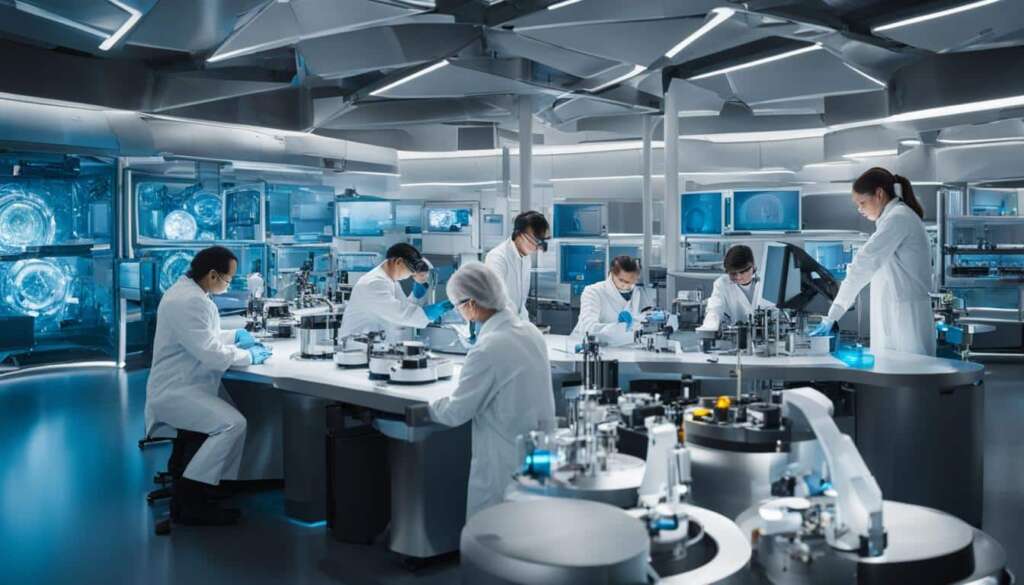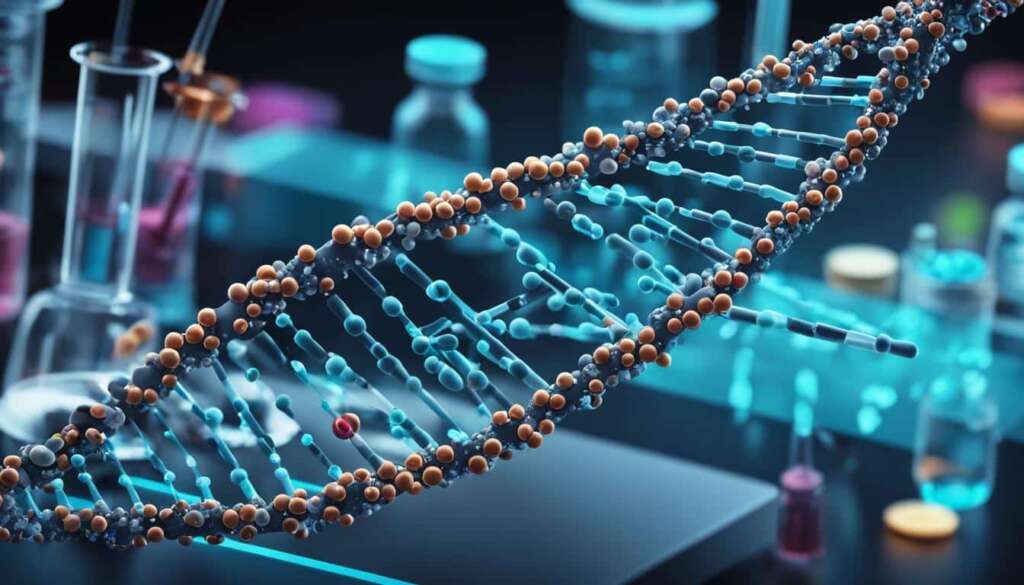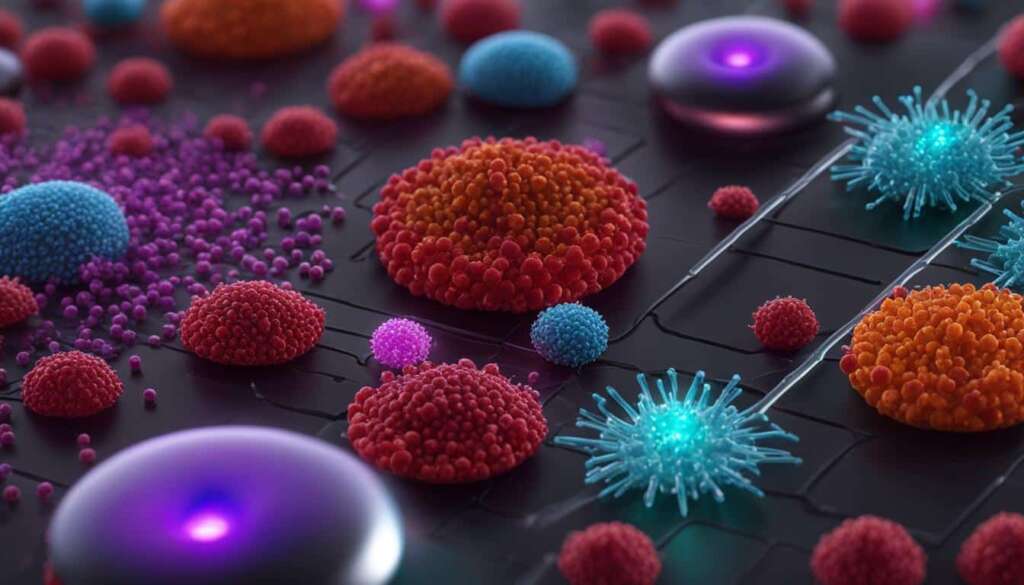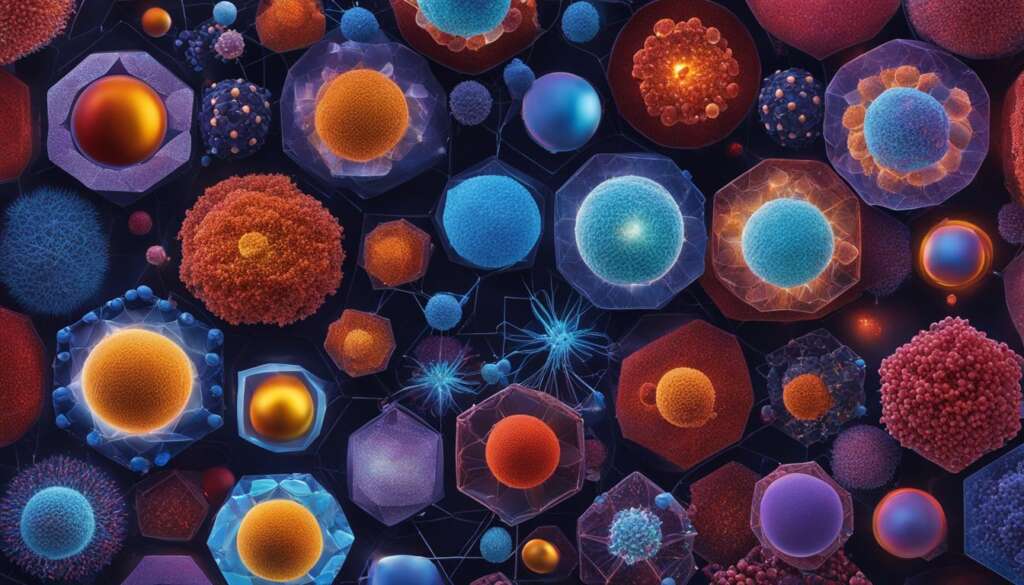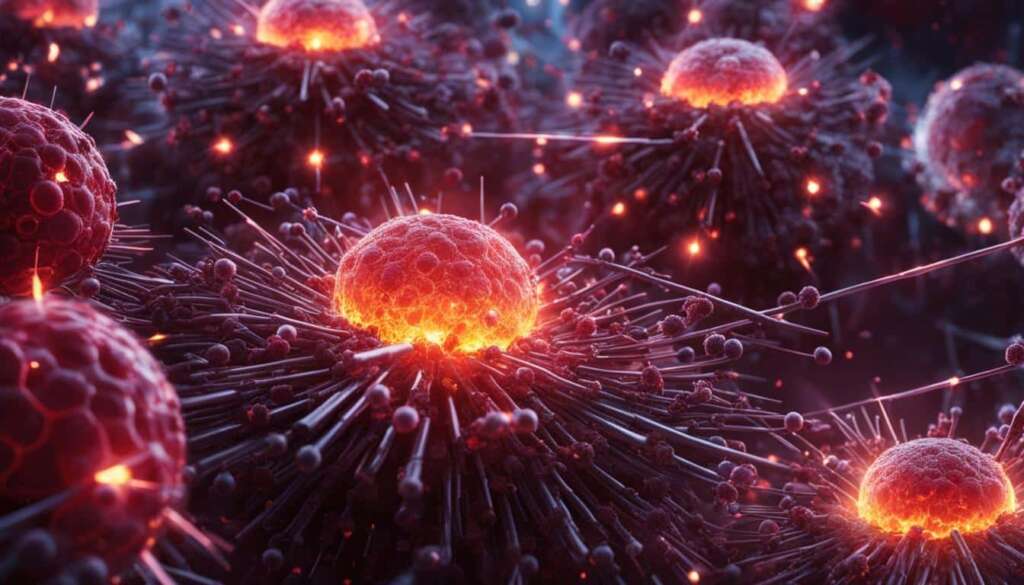Table of Contents
Nanotechnology is poised to have a transformative impact on various industries and everyday life. This rapidly advancing field encompasses breakthroughs in science, chemistry, biology, physics, and engineering. With its ability to understand and manipulate matter at the nanoscale, nanotechnology opens up endless possibilities for novel applications and advancements.
Key Takeaways
- Nanotechnology has significant potential in areas such as materials science, nanomedicine, and device engineering.
- Materials science benefits from nanotechnology through the development of stronger, durable, and self-assembling materials.
- Nanomedicine utilizes nanotechnology for targeted drug delivery, enhanced imaging, and advancements in diagnosis and treatment.
- Nanotechnology revolutionizes industries and manufacturing processes by creating stronger, lighter, and more efficient materials.
- The field of electronics and computing is revolutionized by nanotechnology, enabling smaller and more powerful devices.
What is Nanotechnology?
Nanotechnology is a field that focuses on the understanding and control of matter at the nanoscale, which refers to dimensions between approximately 1 and 100 nanometers. At this scale, materials exhibit unique physical, chemical, and biological properties that differ from those at larger scales. Scientists and engineers leverage these properties to develop novel applications in various industries.
The manipulation of matter at the nanoscale enables the exploration of unique phenomena that arise as a result of quantum effects and surface-to-volume ratio. By harnessing these phenomena, researchers can design materials with tailored properties and functionalities for specific applications.
Nanotechnology plays a pivotal role in driving innovation and advancements across numerous fields. Its potential impact extends from electronics and healthcare to energy and environmental applications. As we delve deeper into the nanoscale world, we unlock new opportunities to address complex challenges and revolutionize industries.
Key Properties of Nanoscale Materials
The nanoscale brings about several unique properties that make nanotechnology so transformative. Some key properties of nanoscale materials include:
- Size-dependent properties: Materials exhibit different properties at the nanoscale compared to their macroscopic counterparts. For example, nanoparticles may have distinct optical, electrical, or magnetic properties that can be precisely tuned.
- Enhanced surface area: Nanoparticles have a significantly higher surface area-to-volume ratio than bulk materials. This property confers enhanced reactivity, making them suitable for various catalytic and sensing applications.
- Quantum effects: At the nanoscale, quantum effects become more pronounced. Quantum confinement and quantum tunneling phenomena give rise to unique electronic and optical properties that can be exploited for advanced devices.
- Self-assembly: Nanoscale materials can self-assemble into complex structures due to their molecular-level interactions. This property paves the way for the development of materials with tailored structures and functionalities.
Applications of Nanotechnology
Nanotechnology finds applications in a wide range of fields, where its unique properties can be harnessed for novel solutions:
- Electronics and Computing: Nanoscale materials enable the miniaturization of electronic components, leading to more powerful and energy-efficient devices. Nanoelectronics and quantum computing are rapidly advancing fields within this domain.
- Healthcare and Medicine: Nanotechnology contributes to the development of targeted drug delivery systems, enhanced imaging techniques, and regenerative medicine. It holds tremendous potential for personalized medicine and improving patient outcomes.
- Energy and Environment: Nanomaterials are employed in clean energy technologies, such as solar cells and energy storage devices. Nanotechnology also aids in environmental applications, including water treatment and air pollution control.
- Materials Science and Engineering: Nanotechnology revolutionizes materials science by enabling the production of stronger, lighter, and more durable materials. It enables advancements in areas like construction, transportation, and manufacturing.
- Agriculture and Food Industry: Nanotechnology offers solutions for crop protection, food safety, and efficient resource utilization in the agriculture sector. It facilitates the development of smart packaging materials and sensors for quality control.
Comparative Analysis of Nanotechnology Applications
| Industry/Application | Key Benefits |
|---|---|
| Electronics and Computing | – Miniaturization of devices – Increased computing power – Enhanced energy efficiency |
| Healthcare and Medicine | – Targeted drug delivery – Improved imaging and diagnostics – Regenerative medicine advancements |
| Energy and Environment | – Clean energy technologies – Water treatment and air pollution control – Energy efficiency improvements |
| Materials Science and Engineering | – Stronger and lighter materials – Enhanced durability – Self-assembling properties |
| Agriculture and Food Industry | – Crop protection and yield improvement – Food safety assurance – Resource utilization efficiency |
Applications of Nanotechnology in Materials Science
Nanotechnology is revolutionizing the field of materials science, paving the way for the development of stronger, more durable, and self-assembling materials. By engineering nanomaterials at the molecular scale, researchers are unlocking new possibilities in various industries, including construction and transportation.
One of the key applications of nanotechnology in materials science is the use of nano particles. These tiny particles, typically ranging from 1 to 100 nanometers in size, exhibit unique properties that contribute to their enhanced strength and durability. By incorporating nano particles into the matrix of materials, scientists can create composites that are significantly stronger and more resistant to wear and tear.
Additionally, nanotechnology enables the creation of self-assembling materials. Through careful design, engineers can develop materials that have the ability to self-organize and form complex structures. This self-assembly process allows for the fabrication of materials with tailored properties, such as improved mechanical strength or enhanced functionality.
Furthermore, nanotechnology plays a vital role in advancing additive manufacturing methods like 3D printing. By incorporating nanomaterials into printing processes, it becomes possible to create intricate and precise structures with improved mechanical properties. This revolutionizes the manufacturing industry, as 3D printing with nanomaterials offers the potential for increased efficiency and customization.
Here is an example of a table showcasing the applications of nanotechnology in materials science:
| Industry | Application |
|---|---|
| Construction | Development of stronger and more durable building materials |
| Transportation | Lightweight yet strong components for vehicles |
| Electronics | Nanoelectronics for smaller and more efficient devices |
As nanotechnology continues to advance, we can expect further breakthroughs in materials science. The ability to manipulate materials at the nanoscale opens up endless possibilities for creating innovative and high-performance materials that will shape the future of various industries.
Impacts of Nanotechnology in Nanomedicine
Nanomedicine is already making significant advancements in the diagnosis, treatment, and drug delivery for various diseases, including cancer. Nanoparticles are being used to develop targeted drug delivery systems, enhance imaging and diagnostic tools, and enable gene sequencing technologies. Nanotechnology is also contributing to tissue engineering and the development of organs.
Advancements in nanomedicine have revolutionized the way diseases are diagnosed and treated. Through the use of nanotechnology, healthcare professionals can now deliver drugs precisely to the affected areas of the body, improving both treatment efficacy and patient comfort. Nanoparticles, with their unique properties, enable targeted drug delivery systems that minimize side effects and maximize therapeutic benefits.
Furthermore, nanotechnology has greatly enhanced medical imaging and diagnostic techniques. By utilizing nanoparticles, doctors and researchers are able to achieve higher resolution images and more accurate diagnoses. Nanoparticles can be engineered with specific properties to enhance contrast and enable more precise imaging of cellular structures.
In addition to drug delivery and diagnostics, nanotechnology has also revolutionized gene sequencing technologies. Nanoparticles can be used to capture and sequence genetic material, allowing for more efficient and accurate genetic testing. This has significant implications for personalized medicine, as it enables tailored treatments based on an individual’s unique genetic profile.
Applications of Nanotechnology in Nanomedicine
| Nanomedicine Application | Description |
|---|---|
| Targeted Drug Delivery | Utilizing nanoparticles to deliver drugs directly to the affected areas of the body, improving treatment efficacy and reducing side effects. |
| Enhanced Imaging and Diagnostics | Using nanoparticles to improve the resolution and accuracy of medical imaging techniques, leading to more accurate diagnoses. |
| Gene Sequencing | Applying nanotechnology to capture and sequence genetic material, enabling more efficient and accurate gene testing. |
| Tissue Engineering | Utilizing nanomaterials to create scaffolds that promote the growth of new tissues and organs, potentially revolutionizing organ transplantation. |
Moreover, nanotechnology plays a key role in tissue engineering and regenerative medicine. By utilizing nanomaterials, scientists can create scaffolds that provide the necessary environment for cells to grow and differentiate into functional tissues and organs. This has the potential to transform organ transplantation by alleviating the scarcity of donor organs and reducing the risk of rejection.
The impacts of nanotechnology in nanomedicine are far-reaching and hold great promise for the future of healthcare. As advancements in nanotechnology continue to accelerate, we can expect to see further breakthroughs in disease diagnosis, treatment, and personalized medicine.
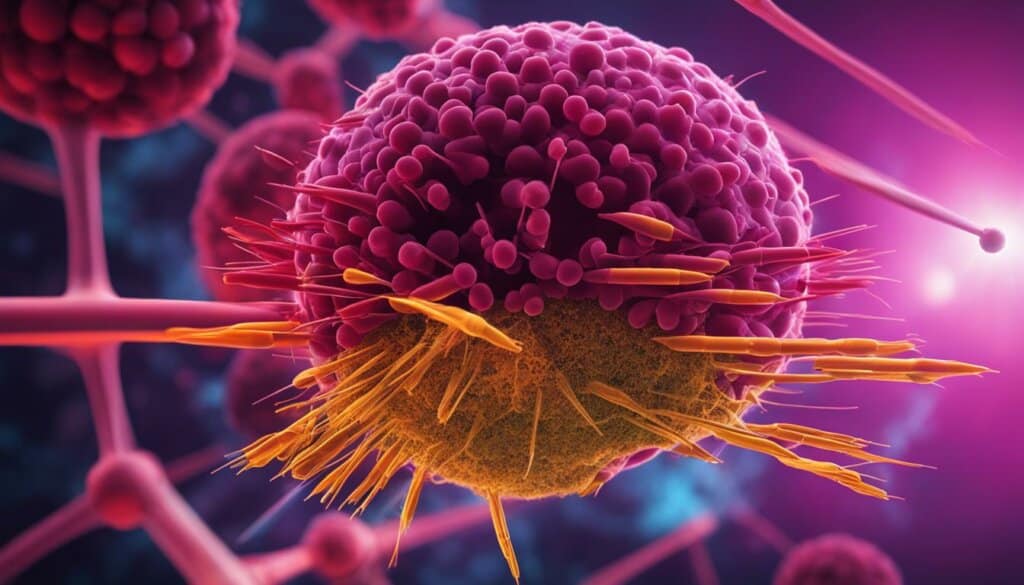
Nanotechnology in Industry and Manufacturing
Nanotechnology is revolutionizing various industries and transforming manufacturing processes. By incorporating nanotechnology-based principles, manufacturers can create materials that are stronger, lighter, and better electrical conductors, leading to improved performance and efficiency in diverse sectors.
The automotive industry is one area where nanotechnology is making notable advancements. By utilizing nanomaterials and nanoparticles, manufacturers can develop stronger and lighter vehicle components, enhancing fuel efficiency and reducing emissions. These nanomaterials also contribute to improved safety features and overall vehicle performance.
In the construction industry, nanotechnology is being employed to create innovative materials that offer enhanced durability, strength, and energy efficiency. Nanomaterials such as nanoparticles, nanofibers, and nanocoatings are used to reinforce structures, making them more resistant to wear, corrosion, and natural disasters. These materials can also provide better insulation and heat management, reducing energy consumption in buildings.
Moreover, nanotechnology plays a crucial role in the food processing industry. By utilizing nanosensors and nanomaterial-based packaging, manufacturers can improve food safety and extend the shelf life of perishable products. Nanotechnology also enables the development of efficient and sustainable food preservation techniques, reducing waste and enhancing the overall quality of food products.
Here is a table summarizing the applications of nanotechnology in different industries:
| Industry | Applications of Nanotechnology |
|---|---|
| Automotive | Stronger and lighter vehicle components, improved fuel efficiency |
| Construction | Durable and energy-efficient materials, enhanced structural strength |
| Food Processing | Improved food safety, extended shelf life, reduced waste |
Additionally, nanotechnology influences manufacturing processes across various sectors, enabling the production of more efficient and durable products. Nanoparticles are used to enhance the performance of manufacturing machinery and equipment, reducing friction and wear. This leads to increased productivity and longer lifespan for manufacturing tools and components.
Furthermore, nanotechnology-based coatings and surface treatments are employed to improve the performance and longevity of industrial equipment, such as turbines and engines. These coatings provide protection against corrosion, erosion, and heat, safeguarding critical components and reducing maintenance costs.
Through constant innovations and ongoing research, nanotechnology continues to revolutionize industry and manufacturing, ushering in a new era of advancements and possibilities.
Nanotechnology in Health and Biomedicine
Nanotechnology plays a pivotal role in revolutionizing healthcare and biomedicine. Its applications span across enhanced imaging techniques, advanced tissue engineering, and targeted drug delivery systems. Through the use of nanoparticles and nanomaterials, significant progress has been made in the development of biosensors, drug delivery systems, and regenerative medicine.
Enhanced Imaging Techniques
Nanotechnology has enabled remarkable advancements in imaging technology, allowing healthcare professionals to obtain highly detailed and precise images of the human body. The use of nanoscale contrast agents enhances the visibility of specific tissues and cellular structures, improving diagnostic accuracy and enabling early disease detection. These enhanced imaging techniques provide healthcare providers with invaluable insights into the workings of the human body, facilitating early intervention and personalized treatment plans.
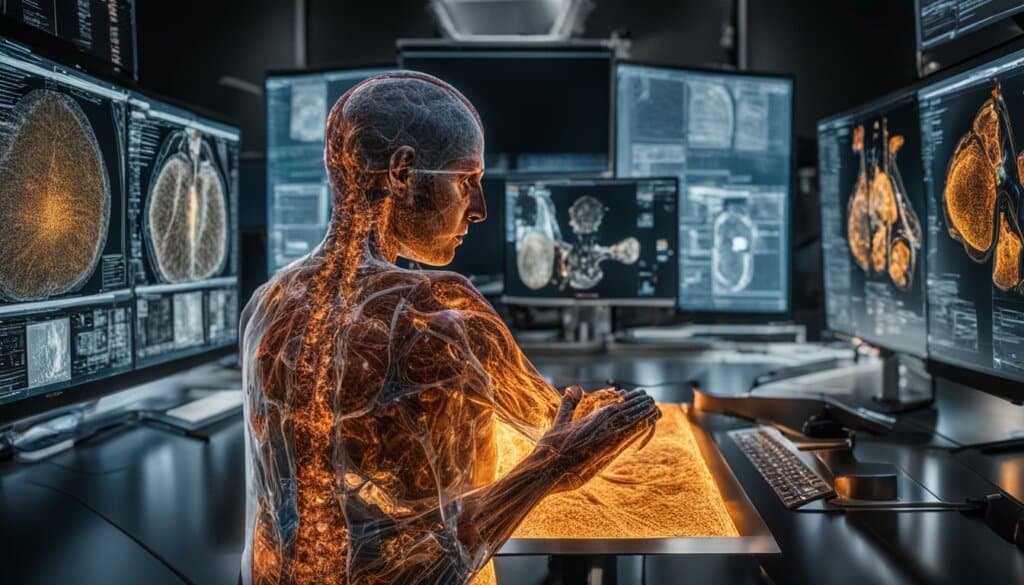
Advancements in Tissue Engineering
Tissue engineering, a field that aims to create functional tissues and organs, has benefited greatly from nanotechnology. By utilizing nanomaterials, scientists are able to engineer scaffolds that closely mimic the properties of natural tissues, promoting cell growth and tissue regeneration. These biomimetic scaffolds provide a framework for tissue growth, such as bone, cartilage, and skin, facilitating the repair and regeneration of damaged or diseased tissues. Additionally, nanotechnology enables the delivery of biomolecules and growth factors to specific target sites, further enhancing tissue regeneration processes.
Targeted Drug Delivery Systems
Nanotechnology has revolutionized drug delivery systems by enabling targeted delivery of therapeutic agents to specific cells or tissues. Nanoparticles can be engineered to encapsulate drugs and release them in a controlled manner, enhancing their efficacy while minimizing off-target effects. These targeted drug delivery systems can improve treatment outcomes in various diseases, including cancer, by concentrating the therapeutic agents precisely where they are needed. Additionally, nanotechnology allows for the development of personalized medicine approaches, tailoring treatments to individual patients based on their unique genetic makeup and disease characteristics.
“Nanotechnology has opened up exciting possibilities in healthcare and biomedicine, enabling enhanced imaging, advancements in tissue engineering, and precise drug delivery systems.”
In summary, nanotechnology is making significant contributions to the field of health and biomedicine. Its applications in enhanced imaging, tissue engineering, and targeted drug delivery systems have the potential to revolutionize healthcare, improve patient outcomes, and pave the way for personalized medicine approaches. The continued advancements in nanotechnology hold promising prospects for the future of medical innovation and biomedicine.
Nanotechnology in Environmental and Energy Applications
Nanotechnology is playing a crucial role in addressing environmental and energy challenges. It offers innovative solutions for various applications, including water treatment, air pollution control, and the development of clean energy technologies. By harnessing the unique properties of nanomaterials, we can improve energy efficiency and reduce environmental impact.
Water Treatment
Nanotechnology has revolutionized water treatment processes, providing more effective and sustainable solutions. Nanomaterials such as nanofilters and nanoparticles can remove contaminants and pollutants from water sources, ensuring cleaner and safer drinking water. These advancements in nanotechnology have the potential to enhance the quality of life and protect natural resources.
Air Pollution Control
Addressing air pollution is a global challenge, and nanotechnology offers promising solutions. Nanomaterials can be used to develop advanced air filters and catalytic converters, effectively capturing and converting harmful pollutants into less harmful substances. By utilizing nanotechnology in air pollution control, we can improve air quality and protect public health.
Clean Energy Technologies
One of the key applications of nanotechnology is in the development of clean energy technologies. Nanomaterials can enhance the efficiency of solar cells, enabling the conversion of sunlight into electricity with higher efficacy. Nanotechnology is also being used to develop lightweight and high-capacity batteries for energy storage, contributing to the advancement of renewable energy systems.
Furthermore, nanotechnology is driving innovations in fuel cell technology, enabling clean and efficient energy generation. By optimizing the design and properties of nanomaterials, we can revolutionize the way we produce and utilize energy, paving the way for a sustainable future.
The Potential of Nanomaterials
Nanomaterials exhibit unique properties at the nanoscale, allowing for precise control and manipulation of their behavior. This opens up endless possibilities for environmental and energy applications. From pollution control to renewable energy, nanotechnology is reshaping our approach to sustainability and providing solutions to some of the most pressing global challenges we face today.
| Environmental Applications | Energy Applications |
|---|---|
| Clean water by removing contaminants | Efficient solar cell technology |
| Air pollution control | Advanced energy storage systems |
| Sustainable waste management | Improved fuel cell technology |
As nanotechnology continues to advance, we can expect further breakthroughs in environmental and energy applications. With investments in research and development, nanotechnology has the potential to lead us towards a cleaner and more sustainable future.
Nanotechnology in Electronics and Computing
Nanotechnology has revolutionized the field of electronics and computing, leading to significant advancements in smaller and more powerful electronic devices. With the ability to manipulate matter at the nanoscale, nanotechnology has paved the way for groundbreaking innovations in electronics, such as nanoelectronics and quantum computing.
One of the key applications of nanotechnology in electronics is in data storage. Nanomaterials, with their unique properties at the nanoscale, have enabled the development of more efficient and compact storage devices. These advancements have led to the evolution of data storage technologies, allowing for higher storage capacities and faster data transfer rates.
Nanotechnology has also played a crucial role in the miniaturization of electronic components. By utilizing nanoscale transistors, manufacturers have been able to create smaller and more energy-efficient devices, enabling advancements in wearable technology, IoT devices, and mobile computing.
The potential of nanoelectronics goes beyond size reduction. It opens up avenues for the development of faster processors, more efficient energy conversion, and novel computing architectures. As nanotechnology continues to advance, so does the potential for quantum computing, which has the power to revolutionize computing by leveraging the principles of quantum mechanics.
“Nanotechnology has transformed the electronics and computing industry, enabling smaller and more powerful devices with enhanced capabilities. The advancements in nanoelectronics and quantum computing have the potential to reshape the future of technology.” – Dr. Sarah Johnson, Nanotechnology Research Scientist
Advancements in Nanotechnology in Electronics and Computing
Here are some notable advancements in nanotechnology in the field of electronics and computing:
- The development of nanoscale transistors that are faster and more energy-efficient.
- The use of nanomaterials in data storage, resulting in higher capacities and faster transfer rates.
- The miniaturization of electronic components, leading to smaller and more compact devices.
- The exploration of quantum computing, which has the potential to solve complex problems at an unprecedented speed.
By harnessing the unique properties of nanomaterials and exploring the possibilities offered by quantum computing, researchers and engineers are pushing the boundaries of electronics and computing, opening up new opportunities for innovation and technological advancement.
| Advancements | Benefits |
|---|---|
| Development of nanoscale transistors | Enhanced performance and energy efficiency |
| Use of nanomaterials in data storage | Higher capacities and faster transfer rates |
| Miniaturization of electronic components | Smaller and more compact devices |
| Exploration of quantum computing | Potential for solving complex problems at unprecedented speeds |
As nanotechnology continues to advance, we can expect further breakthroughs in the field of electronics and computing, leading to even more impressive technological innovations. From smaller and more powerful devices to quantum computing capabilities, nanotechnology is set to shape the future of electronics and computing.

Nanotechnology in Agriculture and Food Industry
Nanotechnology holds immense potential to revolutionize the agriculture and food industry by introducing innovative solutions for crop protection, improving food safety, and enhancing resource efficiency. It offers a wide range of applications that address key challenges in these sectors, paving the way for sustainable and efficient practices.
Advancements in Crop Protection
One of the significant applications of nanotechnology in agriculture is the development of advanced crop protection methods. Nanoparticles and nanomaterials are being employed to create smart delivery systems for pesticides and fertilizers. This targeted approach ensures maximum efficiency and reduces the environmental impact of these chemicals by minimizing their overall usage. Additionally, nanomaterials can enhance the soil’s water-holding capacity and nutrient availability, optimizing plant growth and productivity.
Improving Food Safety
Ensuring food safety is a critical aspect of the food industry, and nanotechnology offers solutions to address this concern. Nanosensors can be utilized to detect and monitor contaminants, such as pathogens, pesticides, and heavy metals, in food products. These sensors provide rapid and accurate results, enabling early detection and prevention of potential health risks. Moreover, nanostructured materials can be employed to develop antimicrobial packaging that extends the shelf life of perishable goods and prevents the growth of harmful bacteria.
Waste Reduction and Resource Efficiency
The agriculture sector faces challenges related to waste generation and resource utilization. Nanotechnology presents opportunities to mitigate these issues and improve overall sustainability. For example, nanomaterials can be integrated into fertilizers to increase nutrient uptake by plants, reducing the amount of fertilizer required. Additionally, nanoscale filtration systems can be employed in water treatment processes, effectively removing contaminants and conserving water resources. These advancements contribute to the efficient use of resources, reducing waste and environmental impact.
| Benefits of Nanotechnology in Agriculture and Food Industry |
|---|
| Enhanced crop protection and reduced environmental impact |
| Improved food safety through rapid detection of contaminants |
| Extended shelf life of perishable goods with antimicrobial packaging |
| Efficient use of resources and waste reduction |
By leveraging nanotechnology in the agriculture and food industry, we can optimize production processes, enhance food quality and safety, and minimize environmental impact. It is essential to continue research and development in this field to unlock the full potential of nanotechnology and drive sustainable advancements across the entire food supply chain.
Nanotechnology in Medicine and Drug Delivery
Nanotechnology is revolutionizing the field of medicine and drug delivery, ushering in a new era of targeted therapies and personalized medicine. By harnessing the power of nanoparticles and nanomaterials, researchers and healthcare professionals are improving the efficacy of drugs while minimizing side effects.
One of the key advantages of nanotechnology in medicine is its ability to deliver drugs directly to specific sites in the body. This targeted drug delivery approach ensures that medications reach their intended destination, maximizing their therapeutic effects. For example, nanoparticles can be engineered to target cancer cells specifically, delivering anticancer drugs directly to the tumor site while sparing healthy cells from potential damage.
Moreover, nanotechnology allows for the development of novel drug delivery systems that enhance drug stability, solubility, and bioavailability. By encapsulating drugs within biocompatible nanoparticles, the release of medications can be carefully controlled, improving their efficacy and reducing the frequency of dosing.
“The use of nanotechnology in medicine has the potential to revolutionize patient care by enabling precise drug delivery and personalized treatment approaches.” – Dr. Sarah Johnson, Medical Researcher
Additionally, nanotechnology plays a crucial role in the advancement of targeted therapies. By coupling nanoparticles with specific ligands or antibodies, drugs can be specifically directed to cells or tissues expressing the corresponding receptors. This targeted approach not only enhances drug efficacy but also minimizes the exposure of healthy tissues to potentially toxic medications.
Furthermore, nanotechnology has paved the way for the development of personalized medicine. By tailoring drug delivery systems to individual patients based on their genetic makeup or specific disease characteristics, personalized treatment approaches can be designed to optimize therapeutic outcomes. Through the use of nanotechnology, healthcare professionals can ensure that patients receive the right medication, at the right dose, and at the right time.
Advantages of Nanotechnology in Medicine and Drug Delivery
Nanotechnology offers several advantages in medicine and drug delivery:
- Targeted drug delivery to specific sites in the body.
- Enhanced drug stability, solubility, and bioavailability.
- Minimized side effects by sparing healthy cells.
- Precise and controlled release of medications.
- Improved drug efficacy through targeted therapies.
- Personalized medicine tailored to individual patients.
Nanotechnology in Medicine and Drug Delivery: Current Applications
Current applications of nanotechnology in medicine and drug delivery include:
| Application | Description |
|---|---|
| Cancer Treatment | Nanoparticles loaded with anticancer drugs are designed to selectively target tumor cells, increasing drug efficacy and reducing side effects. |
| Medical Imaging | Nanoparticles can be used as contrast agents for enhanced imaging, providing detailed visualization of tissues and organs. |
| Gene Therapy | Nanoparticles are utilized to deliver therapeutic genes to specific cells, offering potential treatments for genetic disorders. |
| Antimicrobial Therapy | Nanoparticles can be engineered to carry antimicrobial agents, combating drug-resistant bacteria and infections. |
As nanotechnology continues to advance, the possibilities for medicine and drug delivery are expanding. Researchers and scientists are continually exploring new applications and refining existing methods to unlock the full potential of nanotechnology in healthcare.
By harnessing the power of nanotechnology, the medical field is making significant strides towards targeted therapies, personalized medicine, and improved patient outcomes.
Nanotechnology in Biotechnology and Biomanufacturing
Nanotechnology is revolutionizing the field of biotechnology and biomanufacturing, driving advancements in biosensors, biofuel production, and biomaterial manufacturing.
In biotechnology, nanotechnology has paved the way for the development of highly sensitive and versatile biosensors. These biosensors have numerous applications in medical diagnostics, environmental monitoring, and food safety. By integrating nanomaterials with biological systems, biosensors can detect and analyze specific molecules, enabling rapid and accurate detection of diseases, pollutants, and contaminants.
Another area where nanotechnology is making a significant impact is biofuel production. By leveraging nanomaterials and nanocatalysts, researchers are developing more efficient and sustainable biofuel production processes. Nanoscale catalysts facilitate the conversion of feedstock into biofuels, improving the yield and reducing the energy consumption of the production process. This technology has the potential to revolutionize the biofuel industry, providing cleaner and more renewable energy sources.
Nanotechnology is also playing a crucial role in the manufacturing of biomaterials. By manipulating materials at the nanoscale, scientists can design and fabricate biomaterials with enhanced properties and functionalities. These biomaterials can be used in various applications, such as tissue engineering, drug delivery systems, and medical implants. Nanotechnology enables precise control over the structure and composition of biomaterials, resulting in improved biocompatibility and performance.
To illustrate the transformative potential of nanotechnology in biotechnology and biomanufacturing, consider the following examples:
- A biosensor utilizing nanomaterials and nanodevices can detect cancer biomarkers in a patient’s blood sample, enabling early diagnosis and personalized treatment.
- Nanoparticles can be used as carriers for targeted drug delivery, delivering medications directly to diseased cells while minimizing side effects in the rest of the body.
- Nanomaterials with unique properties can be incorporated into regenerative medicine therapies, promoting tissue regeneration and facilitating organ transplantation.
- Nanocatalysts can improve the efficiency of biofuel production processes, reducing reliance on fossil fuels and mitigating environmental impact.
Overall, nanotechnology is revolutionizing biotechnology and biomanufacturing by enabling the development of biosensors, advancing biofuel production, and enhancing biomaterial manufacturing. As research and development in nanotechnology continue to progress, we can expect further breakthroughs that will shape the future of these fields.
Conclusion
Nanotechnology holds immense promise for the future, with its transformative impact on various industries and everyday life. The advancements in nanotechnology have the potential to revolutionize healthcare, agriculture, electronics, and manufacturing, leading to groundbreaking innovations that will shape our future.
In the healthcare industry, nanotechnology has already made significant strides in areas such as nanomedicine, enabling targeted therapies and personalized medicine. It has revolutionized drug delivery systems, improving efficacy while reducing side effects. Additionally, nanotechnology has contributed to enhanced imaging techniques and tissue engineering, paving the way for breakthroughs in diagnostics and regenerative medicine.
Not only in healthcare, but nanotechnology is also making its mark in agriculture, electronics, and manufacturing. It offers opportunities for crop protection and improved food safety in the agricultural sector. In electronics, nanotechnology has enabled the creation of smaller and more powerful devices, pushing the boundaries of nanoelectronics and quantum computing. In manufacturing, nanomaterials have led to stronger, lighter, and more efficient products, resulting in better performance and energy efficiency.
As innovations in nanotechnology continue to emerge, it is clear that this field will have a transformative impact on various industries and our everyday lives. The future of nanotechnology holds immense potential, with advancements that will shape how we live, work, and interact with technology. Embracing and exploring the possibilities of nanotechnology will undoubtedly unlock new opportunities and revolutionize our world.
FAQ
What is nanotechnology?
Nanotechnology involves understanding and manipulating matter at the nanoscale, which is between approximately 1 and 100 nanometers. At this scale, materials exhibit unique physical, chemical, and biological properties, enabling novel applications and advancements in various industries.
How is nanotechnology revolutionizing materials science?
Nanotechnology is revolutionizing materials science by enabling the development of stronger, durable, and self-assembling materials. Nanomaterials engineered at the molecular scale have the potential to revolutionize industries like construction and transportation. Nanotech principles are also accelerating 3D printing and 4D self-assembling printing, opening up new possibilities in manufacturing.
What are the impacts of nanotechnology in nanomedicine?
Nanotechnology is making significant advancements in the diagnosis, treatment, and drug delivery for various diseases, including cancer. Nanoparticles are being used to develop targeted drug delivery systems, enhance imaging and diagnostic tools, and enable gene sequencing technologies. Nanotech is also contributing to tissue engineering and organ development.
How is nanotechnology transforming industry and manufacturing?
Nanotechnology-based principles are revolutionizing industry and manufacturing processes. By using nanotech, materials can be made stronger, lighter, and better electrical conductors. Nanoparticles and nanomaterials are being used in automotive industry, construction, and food processing, among others, to enhance performance and efficiency.
What are the applications of nanotechnology in health and biomedicine?
Nanotechnology has significant applications in healthcare and biomedicine. It has enabled enhanced imaging techniques, advancements in tissue engineering, and targeted drug delivery systems. Nanoparticles and nanomaterials are being used in the development of biosensors, drug delivery systems, and regenerative medicine.
How is nanotechnology addressing environmental and energy challenges?
Nanotechnology is playing a crucial role in addressing environmental and energy challenges. It is being used in various applications, such as water treatment, air pollution control, and the development of clean energy technologies. Nanomaterials have the potential to improve energy efficiency and reduce environmental impact.
How is nanotechnology impacting electronics and computing?
Nanotechnology has revolutionized the field of electronics and computing. It has enabled the development of smaller and more powerful electronic devices, nanoelectronics, and quantum computing. Nanomaterials are being used for data storage, nanoscale transistors, and the miniaturization of electronic components.
What are the applications of nanotechnology in agriculture and the food industry?
Nanotechnology has the potential to transform the agriculture and food industry. It is being used for crop protection, improved food safety, and the development of smart packaging materials. Nanotech also offers opportunities for waste reduction and more efficient use of resources in the agriculture sector.
How is nanotechnology revolutionizing medicine and drug delivery?
Nanotechnology is revolutionizing medicine and drug delivery by enabling targeted therapies and personalized medicine. Nanoparticles and nanomaterials are being used to deliver drugs to specific sites in the body, improve drug efficacy, and reduce side effects. Nanotech also allows for the development of novel drug delivery systems.
What are the impacts of nanotechnology in biotechnology and biomanufacturing?
Nanotechnology is transforming the field of biotechnology and biomanufacturing. It has enabled the development of biosensors for various applications, including medical diagnostics and environmental monitoring. Nanotechnology is also being used in biofuel production and the manufacturing of biomaterials.
Can nanotechnology have a transformative impact on industries and everyday life?
Absolutely. Nanotechnology holds immense promise for the future, with transformative impacts on various industries and everyday life. It has the potential to revolutionize fields such as healthcare, agriculture, electronics, and manufacturing. As innovations in nanotechnology continue to emerge, we can expect to see groundbreaking advancements that will shape our future.




